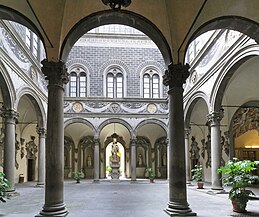
Palazzo Medici Riccardi
The Palazzo Medici, also called the Palazzo Medici Riccardi after the later family that acquired and expanded it, is a Renaissance palace located in Florence, Italy. It is the seat of the Metropolitan City of Florence and a museum.
For other uses, see Palazzo Medici (disambiguation).Palazzo Medici Riccardi
History[edit]
The Palazzo Medici Riccardi was built after the defeat of the Milanese and when Cosimo de Medici had more governmental power. Rinaldo degli Albizzi had also died giving Cosimo and his supporters even more influence.[4] With this new political power Cosimo decided he wanted to build a palazzo. He was able to acquire property from his neighbors in order to begin the building of the palazzo. Unlike other wealthy families however, Cosimo wanted to start fresh and cleared the site before he began building. Most other families, including those from wealthy backgrounds, built from what was already present. During this time, there was also a concern over sumptuary laws which affected how much wealth one could display or how to display wealth without displaying wealth. Cosimo agreed with this law and believed in this ideal possibly because of his status within the Signoria of Florence. As Pater Patriae, Cosimo was able to find ways around it through building materials and the idea of having the exterior of the building simpler and modest while the inside was more decorated. It was larger than other palazzi but its more modest design made it less noticeable. Yet, Cosimo's attempts at modesty did not help later on when the Medici family was scrutinized for their political power. Accused of spending money that was not his, Cosimo's house became part of arguments claiming that the Medicis built the Palazzo with money that was not theirs.[5]
The palace remained the principal residence of the Medici family until the exile of Piero de Medici in 1494. Following their return to power the palace continued to be used by the Medici until 1540 when Cosimo I moved his principal residence to the Palazzo Vecchio. The Palazzo Medici continued to be used as a residence for younger family members until, too austere for Baroque era tastes the palace was sold to the Riccardi family in 1659. The Riccardi renovated the palace and commissioned the magnificent gallery frescoed with the Apotheosis of the Medici by Luca Giordano. The Riccardi family sold the palace to the Tuscan state in 1814 and in 1874 the building became the seat of the provincial government of Florence.[6]
Architecture[edit]
Michelozzo had become a favorite of Cosimo due to his attention to tradition and his style for decoration. Michelozzo had studied under Brunelleschi and some of his work was influenced by the renowned architect and sculptor. However, Brunelleschi had proposed a design to Cosimo but was believed to be too sumptuous and extravagant and was rejected for Michelozzo's more modest design, although Brunelleschi's style can still be seen in the palazzo. The courtyard of the palazzo was based on the loggia of the Ospedale degli Innocenti, a Brunelleschian design.[7]
The Palazzo Medici Riccardi was different for its time, and was the start of several architectural breakthroughs. It was believed to be the combination of Michelozzo's traditional and progressive elements that set the tone and style for future palazzi. The palazzo was the first building in the city to be built after the modern order including its own separate rooms and apartments. The palazzo was also a start to not only Michelozzo's climb in status as an architect, but also as "the prototype of the Tuscan Renaissance palazzo," and became a repeated style in many of Michelozzo's later work. It was one of the first buildings to have a grand staircase that was not a secular design and for a building of this time and the status symbol of the client at the time, it was a simple and modest-looking building, however it was one of Michelozzo's most important commissions for the family and became a standard for other housing designed by him in years to come. The palazzo itself is based on medieval design with other components added to it. The design was meant to be simpler but set in such a way that it still showed the wealth of the Medici family through use of materials, the interior and the simplicity.[8]
The building materials used for the construction were meant to accentuate the structure of the building through the threefold grading of masonry, rusticated blocks on the ground floor, the ashlar face of the top story, and the cornice. The exterior design of the rusticated blocks and ashlar also create an optical recession that makes the building look even larger by the use of rough texture to smoother textures as the building heightens.[4] The cornice in the palazzo was also the first time it debuted fully developed, giving the palazzo more significance in a historical context. The Medici were still able to show their wealth on the exterior through their building material choices. The rusticated blocks soon became seen as a status symbol as the materials were costly and rare. They also, later, became a large part of power politics that was believed to have started with the Palazzo Medici Riccardi.[8]
The palazzo is divided into different floors. The ground floor contains two courtyards, chambers, anti-chambers, studies, lavatories, kitchens, wells, secret and public staircases and on each floor there are other rooms meant for family.[9]






